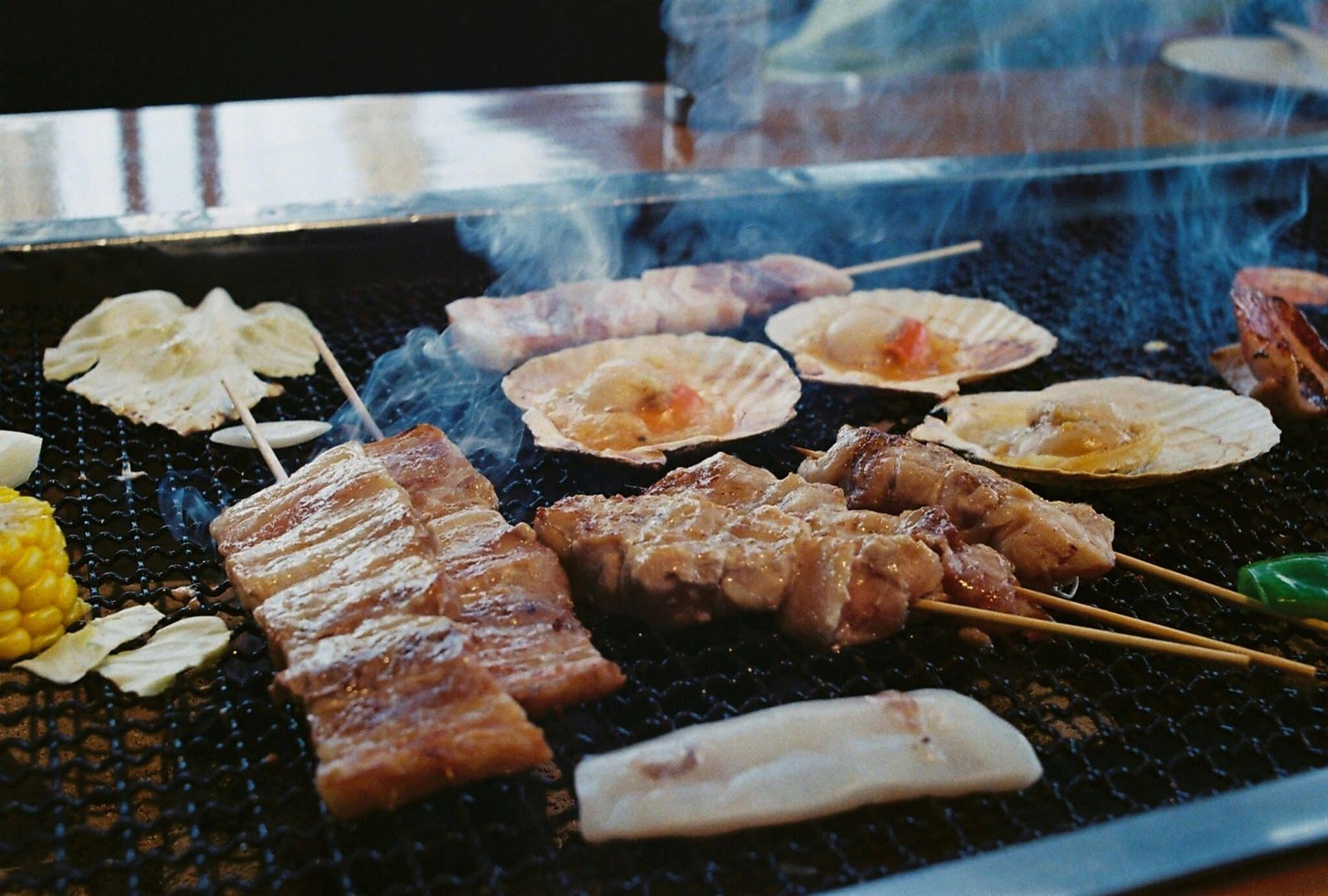Japanese vs Chinese food is a never-ending discussion. Both cuisines are a part of the amazing East Asian food traditions. However, they are very different in what they offer. One major difference is that Japanese dishes focus on subtle flavors and beautiful presentations. In contrast, Chinese cuisine uses bold spices and a variety of cooking techniques. Notably, Japanese cuisine involves cooking with fewer spices so the ingredients shine. When you look at the differences, you discover an interesting mix of cultural influences and cooking artistry.
Exploring the Roots: Japanese vs Chinese food
Foremost, Japanese cuisine focuses on fresh seafood and seasonal ingredients. However, over many years, it has changed along with cultural practices. Gradually, it took some ideas from other Asian countries but created its own style.
On the other hand, Chinese cuisine is very varied. It has many dishes that come from different regions. Also, history played a big part in shaping its flavors. Chinese cooking cares about taste and nutrition. From the spicy tastes of Sichuan to the light flavors of Cantonese food, there is something in China’s food culture for everyone. Here is the breakdown of the ingredients in Japanese vs Chinese food
Popular Chinese Foods
The popular Chinese dishes offer a delightful mix of flavors and textures that are sure to tantalize your taste buds!
Kung Pao Chicken: The ingredients are chicken, peanuts, vegetables, chili peppers, soy sauce, vinegar, and, also, sugar.
Peking Duck: The ingredients include duck, hoisin sauce, scallions, cucumbers, and pancakes.
Hot Pot: You can use beef or lamb. In addition, the hot pot requires vegetables, tofu, noodles, and a variety of dipping sauces.
Mapo Tofu: Ingredients are primarily Tofu or minced meat. Mapo includes fermented black beans, chili paste, and Sichuan peppercorns.
Dim Sum: Ingredients vary depending on the type of dish. However, the common include shrimp, pork, mushrooms, and bamboo shoots that the chef wraps in rice or wheat dough.
Chow Mein: you can order stir-fried noodles with vegetables like cabbage and carrots in addition to bean sprouts. Also, you have choice of protein such as chicken or beef.
Spring Rolls: The chef uses thin wrappers to fill with shredded vegetables like cabbage and carrots. Furthermore, you can deep-fry or freshly cut shrimp.
Szechuan Beef: Beef strips stir-fried with Szechuan peppercorns, garlic, ginger and soy sauce. In addition, the dish includes vegetables like bell peppers and broccoli.
Sweet and Sour Pork: Pork pieces coated in batter and fried until crispy. Next, you fry the protein in a tangy sweet-and-sour sauce made from vinegar, sugar, ketchup or tomato sauce.
Popular Japanese Foods
Food lovers celebrate Japanese cuisine for its unique flavors, fresh ingredients, and meticulous preparation.
Sushi: Foremost, the iconic dish typically consists of vinegared rice combined with seafood such as raw fish (sashimi), cooked shrimp, or crab. However, vegetarian options like avocado or cucumber are also common.
Ramen: A beloved noodle soup dish featuring wheat noodles served in a flavorful broth. Ingredients often include sliced pork (chashu), soft-boiled eggs, green onions and seaweed in addition to various vegetables.
Okonomiyaki: Japanese savory pancake or pizza, okonomiyaki, is made with a batter of flour, grated yam, eggs and shredded cabbage. However, you have a choice of ingredients like pork belly, shrimp, or octopus.
Yakitori: Skewered and grilled chicken pieces brushed with a savory-sweet soy-based sauce known as tare. The chef uses Chicken thighs (momo), chicken skin (kawa), and other parts for the broth.
Miso Soup: A traditional Japanese soup made from dashi stock (fish or seaweed broth) combined with miso paste and ingredients like tofu cubes, wakame seaweed, sliced green onions, and sometimes mushrooms.
Tonkatsu: the breaded and deep-fried pork cutlet are served with tonkatsu sauce. In simple terms, it is a thick sauce created from fermented fruits. Finally, the server completes the dish with shredded cabbage salad with sesame dressing and steamed rice.
Takoyaki: Octopus-filled savory balls made from a wheat-flour batter cooked in a special molded pan. Also, the toppings may include bonito flakes, Takoyaki sauce, mayonnaise, and seaweed powder.
Matcha Green Tea Ice Cream: Lastly, a popular dessert made from matcha powder mixed into ice cream base ingredients like cream, milk and sugar. Sometimes, egg yolks are used for richness.
The Historical Journey of Japanese Cuisine
Japanese food has changed a lot over time. Initially, it first consisted mostly of rice, fish, and vegetables that changed with the seasons. However, other countries also affected its development. The Edo period introduced new ingredients and different cooking styles.
Miso soup, an important part of Japanese meals, became popular. It highlights the rich flavors that fermentation can bring. Sushi, which many people now think of as a main part of Japanese cuisine, started as a way to preserve fish. Now, it has since evolved into an art.
Today, Japanese cuisine is known for its fresh ingredients, light flavors, and, also, beautiful presentation. It continues to attract food lovers and travel bloggers from all around the world.
The Art of Japanese vs Chinese Foods
Foremost, Japanese cooking techniques focus on keeping the natural flavors and textures of ingredients. Initially, raw fish is very important in Japanese cuisine. It is carefully prepared in dishes like sushi and sashimi. In other words, it shows the chef’s knife skills and respect for freshness.
Other common cooking methods include grilling, steaming, and simmering. The methods bring out the delicate flavors of seafood, vegetables, and tofu. Tempura is a light and airy batter that makes ingredients crispy and delicious.
Next, restaurants and home cooks serve Japanese dishes with great care. They are presented in beautiful arrangements that highlight simplicity and elegance. The way food looks is just as important as its taste. Therefore, the food represents Japanese culture values beauty in life.
The Evolution of Chinese Culinary Traditions
On the other hand, Chinese food is famous for its wide variety. Each region has different flavors and cooking styles. For example, Peking duck is known for its crispy skin and soft meat. It shows great cooking skills from Northern China. In contrast, Sichuan cuisine uses Sichuan peppercorns that create a unique spicy feeling. It also has strong flavors.
Chinese cooking uses many techniques like stir-frying, steaming, and braising. The methods have influenced food all over the world. Dishes such as Kung Pao chicken and Mapo Tofu are known for rich flavors and careful preparation. In gist, they show the talent in Chinese culinary traditions.
Japanese vs Chinese Food Cooking Techniques
Chinese cooking includes many methods that help create its unique tastes and textures. Stir-frying is very important in Chinese cooking. It cooks food quickly in a hot wok. Moreover, it keeps the vegetables crispy and cooks the proteins nicely.
Secondly, steaming is another common method. It helps keep the nutrients and natural taste of the food. People often steam fish, dumplings, and vegetables. However, deep-frying is not used as much as stir-frying. Nonetheless, it makes the dishes crispy and tasty. Also, you can include items like spring rolls and General Tso’s chicken. In contrast, stir frying offer a quick cooking option that also enhances flavor.
Chinese cuisine affects food all over the world. Its cooking techniques and flavors have inspired many adaptations. Therefore, you cannot ignore its strong influence on global food culture.
Japanese vs Chinese food: Core Ingredients and Flavor Foundations
The Japanese vs Chinese food conversation finds a common ground because of similar ingredients like soy sauce, rice, and noodles. However, the main flavors are quite different. Th difference comes from how the chefs use seasonings, spices, and key ingredients.
Japanese cuisine often has subtle flavors. It lets the natural flavors of ingredients stand out. On the other hand, Chinese cuisine goes for bolder tastes. It uses a mix of spices and seasonings. As a result, the approach creates rich and layered flavors.
Key Ingredients in Japanese vs Chinese Food
Japanese cuisine focuses on fresh and seasonal ingredients. Seafood, especially raw fish, is very important. Dishes like sushi and sashimi show off the gentle taste of the ocean. Furthermore, rice is a key part of Japanese meals. It is usually short-grain and sticky. However, it is a good base for other flavors.
Secondly, soy sauce is used in smaller amounts than in Chinese cuisine,. Yet, it brings a tasty depth to the dishes. Other key seasonings are mirin (a sweet rice wine), sake (rice wine), and dashi (a savory broth made from kombu seaweed and bonito flakes).
Moreover, green tea plays a big role in Japanese culture and cuisine. Its light bitterness and plant-like notes work well with the clean flavors of Japanese dishes. Therefore, it is a healthy drink to have with any meal.
Essential Elements of Chinese Cuisine
Japanese vs Chinese food overlap because of flavors. However, a few ingredients are important. Soy sauce is a staple in Chinese cooking. It adds a savory base to many dishes. Moreover, ginger and garlic give strong aromas and improve the taste.
Black beans add a salty and slightly sweet flavor to stir-fries and sauces. Hoisin sauce is made from fermented soybeans, garlic, and spices. As a result, it brings a rich taste to dishes like Peking duck.
Thirdly, sesame oil has a nutty smell. It adds a great finish to stir-fries and noodle dishes. Also, it boosts flavor profile. You can manipulate the ingredients to create complex and balanced flavors found in Chinese cuisine.
Japanese vs Chinese food: Cooking Techniques and Presentation Styles
The Japanese vs Chinese food discussion continues because of how different they are in how the cooks prepares and presents the food. The dissimilarities show the unique cooking ideas.
Japanese cuisine focuses on precision and simplicity. Moreover, it highlights the quality and freshness of ingredients. On the other hand, Chinese cooking has a bold and varied style. It uses many cooking techniques to create rich flavors and textures. From stir-frying to steaming, each method adds to the special mix of Chinese food.
Japanese vs Chinese food: Spotting Key Differences
- First, Japanese cuisine is known for its delicate flavors. Also, it emphasizes fresh ingredients and minimalist presentation.
- Secondly, Chinese cuisine has bold flavors. The diverse cooking techniques like stir-frying and deep-frying are popular in addition to a wide range of spices.
- While rice is a staple in both cuisines, it is prepared and used differently. Japanese cuisine favors short-grain and sticky rice. In contrast, Chinese cuisine often uses long-grain rice.
- Furthermore, seafood plays a significant role in Japanese cooking because of the islandic geography. However, Chinese cuisine incorporates a wider variety of proteins.
- Lastly, both cultures have unique dining customs and etiquette that enhance the culinary experience.
What’s on the dinner menu today?
Japanese and Chinese cuisines are very different. They have unique origins, key ingredients, and cooking techniques. Japanese food often uses fresh and seasonal ingredients with very little seasoning. Moreover, it focuses on the natural flavors of the food.
Chinese cuisine, however, has a variety of flavors and textures. It uses many spices and different cooking methods. You must learn the differences to appreciate the food more. Japanese vs Chinese food shows us the rich cultural backgrounds of the two cooking styles. Whether you enjoy the simple delicacy of Japanese dishes or the bold complexity of Chinese cuisine, both are a treat for the taste buds. Visit https://bornomalathebd.com/ to expand your knowledge pool today.
Frequently Asked Questions
What are the main differences in seasoning between Japanese and Chinese food?
Japanese seasonings, such as soy sauce, miso, and rice vinegar, are usually lighter. They help bring out natural flavors. On the other hand, Chinese cuisine uses soy sauce more generously. Furthermore, it also includes strong spices like Sichuan peppercorns, star anise, and sesame seeds for richer and bolder tastes.
How do Japanese and Chinese approaches to seafood vary?
Japanese cuisine usually includes raw fish in dishes such as sushi and sashimi. It focuses on freshness and mild flavors. In contrast, Chinese cuisine often cooks seafood. It uses methods like stir-frying, steaming, and deep-frying. In addition, Chinese dishes commonly have strong sauces and spices.
Can you compare the use of rice in Japanese versus Chinese meals?
Japanese rice is a type of short-grain rice. It becomes sticky when cooked and is often served plain. It is a staple that goes well with many dishes. On the other hand, Chinese meals usually use long-grain rice. The rice is often stir-fried with other ingredients. Therefore, it is more flavorful and filling.














